 The Southern
Colonies
The Southern
Colonies
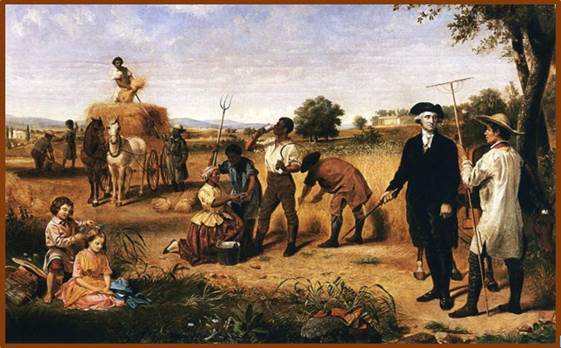
Artist's
Rendition of George Washington's Plantation:
Painted by Junius Brutus Sterns, 1851
Unit
Overview
Since
the founding of Jamestown in 1607, the English continued to establish colonies
along the southeastern shore of the North American continent. The Southern Colonies, which included
Virginia, Maryland, North Carolina, South Carolina and Georgia, attracted both
proprietors and settlers. A long growing
season and rich soil encouraged the growth of cash crops and provided
opportunities for large profits.
However, rice, indigo and tobacco were labor-intensive and required
large numbers of workers. As prices on
the world market became more competitive, indentured servants and African slaves
were used to work large tracts of land known as plantations. Was profit the only reason behind the
founding of the Southern Colonies? Why
did the use of African slaves increase so dramatically, and how did slavery
become a race-based institution? Let’s
see how it all happened.
Filling
the Labor Gap
As
the English soon discovered, the establishment of colonies demanded a large
amount of physical labor. Clearing land,
constructing houses, planting crops and tilling fields intensified the need for
workers. To fill the gap, many people
came to North America as indentured
servants. To pay for their passage,
these individuals signed contracts to work without pay for a specified number of
years. Although agreements varied, a
seven-year term of service was the most common.
When they completed their obligation, indentured servants were freed and
given a small piece of property.
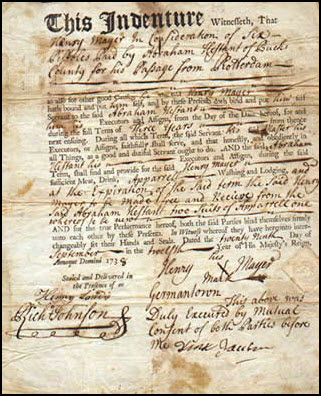
Original Contract for an Indentured
Servant
African
slaves, brought to the colonies against their will, also provided the labor
necessary to build the English colonies.
In 1619, a Dutch trader arrived in Jamestown and sold twenty Africans to
the English settlers. Slavery has long
been associated with the American South, but it existed in the New England and
Middle Colonies during the colonial period.
Although their overall numbers were small in these areas, the cities
held the largest concentrations of blacks.
For example, 20% of Boston’s population was made up of Africans by 1750. In northern urban areas, the enslaved served
as household servants, craftsmen and dock workers.
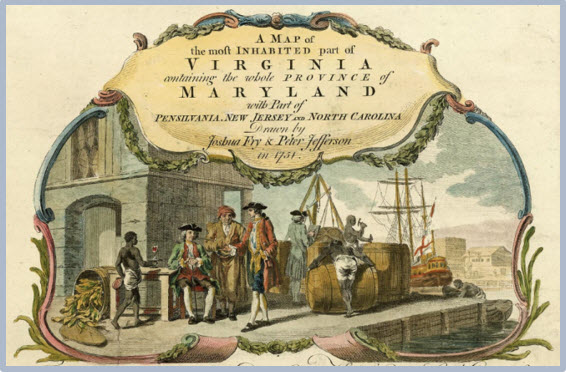
Illustration from the
Jefferson/Fry Map of Virginia: Courtesy
of the University of Virginia Archives
In
the Southern Colonies, slaves primarily were purchased for agricultural work. Some of the first Africans in Virginia were
treated as indentured servants and became freemen. They purchased land, owned indentured
servants and raised families. When
tobacco prices on the world market fell in the 1660s, opportunities for blacks
in the Southern Colonies quickly diminished. When profits decreased, English
planters relied more and more on slaves to maintain their earnings. Virginians passed laws in their colonial
legislature to deny gun ownership to Africans and to strip them of their legal
rights. Other southern colonies that
depended on labor-intensive crops passed similar measures. As a result, Africans were marked as
inferior, and racially based slavery became a permanent condition for those who
continued to arrive involuntarily.
 Go to Questions 1 through 5.
Go to Questions 1 through 5.
Founding
Maryland
Sir George Calvert, titled Lord Baltimore, asked King Charles I to
grant him a charter for a tract of land in the New World. He hoped to achieve two goals by acquiring
this property. Calvert planned to create
a safe home for Roman Catholics, who were persecuted in England, and to
increase the family fortune. When the
king issued the document in 1632, the elder Calvert had died so his son Cecil
inherited the project. As the
proprietor, he had the right to appoint a governor, give land to others, coin
money and make laws. Rather than go to North America himself, the new Lord
Baltimore sent his two brothers to establish a settlement. They arrived in 1634 accompanied by 200
settlers. The colony, located between Pennsylvania and Virginia, was named Maryland. To learn more about its founding, watch the
video listed below.
![]() Maryland: The Proprietary
Colonies
Maryland: The Proprietary
Colonies
Since
Virginia had realized profits from the sale of tobacco, the Maryland colonists
planted it but wanted to avoid becoming too dependent on a single crop. Therefore, farmers who grew tobacco agreed to
set aside at least two acres for corn.
This encouraged the Marylanders to cultivate wheat, fruits, vegetables
and other staples to feed their families.
The town of Baltimore, founded
in 1729, provided a good seaport and became the colony’s largest
settlement. In the meantime, the
Calverts gave large estates to their relatives and friends. As the number of plantations grew, the need
for workers increased. Choosing not to
recruit farmhands and not to offer wages, landowners purchased enslaved
Africans and the contracts of indentured servants to provide the necessary
labor.
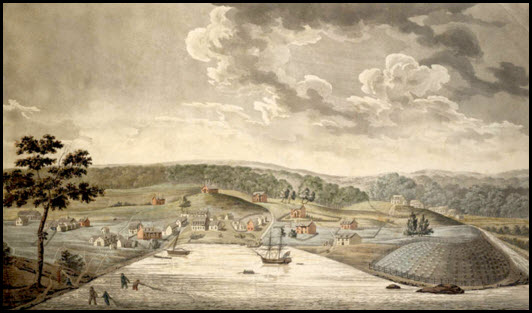
Baltimore in 1752:
Edward J. Coale, 1817
The Calvert
family continued to face challenges as the colony grew. The colonists soon demanded some say in their
government, and Lord Baltimore permitted the election of an assembly to make
laws. Because the colony was originally
intended to be a haven for Catholics, the arrival of large numbers of
Protestants was a concern. In an effort
to protect Catholics from religious persecution by the Protestant majority,
Lord Baltimore convinced the legislative assembly to pass the Act of Religious Toleration which permitted
religious freedom throughout the colony.
There were also border disputes between Pennsylvania and Maryland. To resolve these issues, Charles Mason and Jerimiah
Dixon, two European scientists, were hired to survey the dividing line
between the two colonies. They marked
the border, known as the Mason-Dixon
Line, with stones displaying the Calvert family crest on one side and the
Penn crest on the other.
 Go to Questions 6 through 10.
Go to Questions 6 through 10.
Virginia
and Bacon’s Rebellion
As
other colonies were founded, Virginia continued to grow. Because wealthy tobacco planters occupied the
best land near the coast, new settlers moved inland and pushed westward. By the 1640s, they had come into conflict
with the Native Americans who inhabited the same region. William
Berkeley, Virginia’s governor, hoped to avoid a confrontation like King
Philip’s War by negotiating an agreement with the Indians. In exchange for extending the colony’s land
in the west, Berkeley pledged to keep the settlers from advancing any further
into Indian holdings. The westerners, led by Nathaniel Bacon, opposed this arrangement because they wanted to
clear more land for their farms. They
also believed that the governor was simply trying to preserve the colony’s
valuable fur-trading business with the Indians.
Bacon and Berkeley defended their positions with public statements like
the ones quoted below.
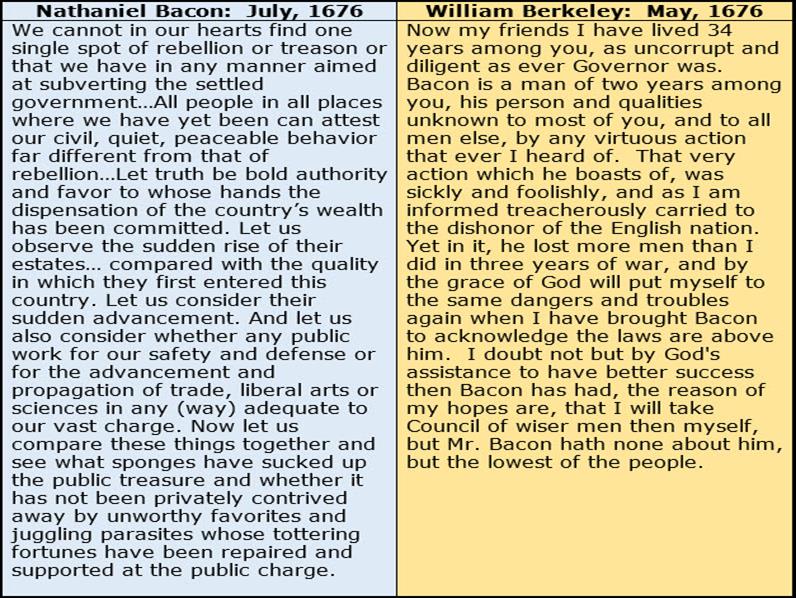
In
1676, Bacon and his supporters attacked Native American villages and tried to
take more land from the Indians by force.
Determined to crush the rebellion, Governor Berkeley organized his own
army, but Bacon’s forces marched on Jamestown, set fire to the town and drove
out the governor. Before he could take
charge of Virginia’s government, Nathaniel Bacon contracted an illness and
died. This ended the rebellion, but the
event had some significant consequences.
Virginia’s colonists had discovered that a group of unified citizens
could be a powerful force, and the Indians had learned that guarantees concerning
their land meant little to the European settlers.
 Go to Questions 11 through18.
Go to Questions 11 through18.
The
Carolinas
As a
reward for their support, King Charles II offered eight of his friends a
proprietary colony south of Virginia in 1663 and named the territory Carolina based on the Latin word for
Charles. The eight proprietors reserved
large estates for themselves and planned to make a profit by selling or renting
the remainder. Colonists began to arrive
in 1670, and they built Charles Town or, as it was eventually called, Charleston. Charleston grew into the fourth largest city
on the eastern seaboard. Because the
colony was large, climate and geography differed from north to south. The northern section of Carolina with its
large forests and less humid climate attracted farmers who grew tobacco and cut
trees for lumber. Because there were no
adequate harbors along the northern coast of the colony, settlers relied on
Virginia’s ports and merchants to conduct their trade.
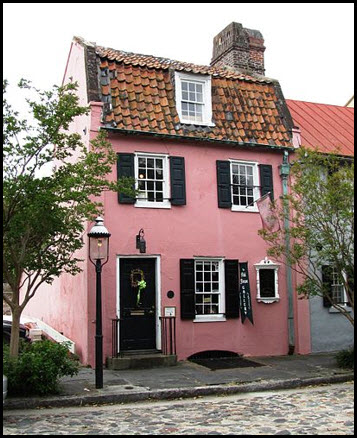
The Pink House, Charleston's Oldest
Building: Photo by Brian
Stansberry/Creative Commons
The
southern half of the colony was blessed with rich soil and an excellent harbor
at Charles Town. Many of the settlers in
this region came from Barbados and
other English colonies in the Caribbean.
They brought their slaves with them. By 1680, planters discovered that rice grew well in the warm, humid
coastal lowlands, and it soon became the colony’s leading crop. In the 1740s,
another valuable plant would provide additional profits. Learn more about South Carolina’s developing
plantation economy by viewing the video listed below.
Colonel George Lucas, a British
officer stationed in the West Indies on the island of Antiqua, moved his family
to a plantation in the Carolinas. After
he returned to duty, his daughter Eliza
Lucas Pinckney looked for ways to keep the plantation out of debt. She experimented with seeds of the indigo plant that her father had sent
from the West Indies. When properly
cultivated and processed, indigo yielded a rich, blue dye popular for coloring
cloth in Europe. Eliza not only made
money for herself with the indigo trade, but she also shared seeds with her
neighbors. This created another valuable
cash crop for the Carolinas.
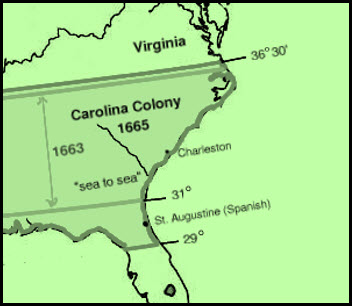
Map Showing the Carolina Colony
Like
rice, the growth of indigo was labor-intensive so the demand for slaves
increased. By the early 1700s, more than
half of the people living in southern Carolina were enslaved Africans. At the same time, the colonists grew
increasingly dissatisfied with the proprietors, and they demanded a greater
role in the colony’s government. By
1729, Carolina had become the two royal colonies of North Carolina and South
Carolina.
 Go to Questions 19
through 21.
Go to Questions 19
through 21.
Oglethorpe’s
Experiment
Georgia, the last of Britain’s colonies in
North America, was established in 1733. James Oglethorpe and nineteen other
proprietors received a charter to create a settlement where poor people and
those who were deeply in debt could make a new life for themselves. For the British government, Oglethorpe’s idea
served a second purpose. Because Spain
and England were at war in the early 1700s, England feared an attack launched
from Spain’s forts in Florida. Since
Georgia, as the new colony was named, was located below South Carolina, it
could act as a buffer to help protect the English from the Spanish.
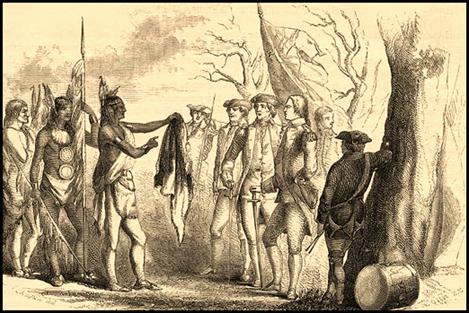
Oglethorpe Meeting with Chief Yamacraw of the
Tomochichi Tribe
In
1733, Oglethorpe and his first group of settlers that had been handpicked by
the proprietors arrived in North America. Some of their first projects included
the construction of a series of forts to defend themselves from the Spanish and
the establishment of the town of Savannah. In
terms of daily life, Oglethorpe had a very specific vision for the colony. Thinking that small farms would encourage the
settlers to do their own work, he gave each one only fifty acres of land, tools
and seeds. Because he wanted his colonists to be independent, hardworking and
Protestant, strict rules outlawed slavery, rum and Catholicism. The video listed below describes Oglethorpe’s
laws and their impact.
Even
though Georgia’s farms successfully produced rice, indigo, corn, wheat and
livestock, the colony’s growth was disappointingly slow. Only a few debtors took advantage of
Oglethorpe’s offer, but hundreds of poor people did migrate to Georgia. They came from Great Britain, Germany,
Switzerland and other European nations.
In a few years, Georgia’s population had the largest percentage of
non-British residents within the thirteen colonies. Although they came from diverse backgrounds,
the colonists agreed that Oglethorpe’s laws were too restrictive and too numerous. He finally permitted the settlers have larger
farms and lifted the ban on slavery. For
the colonists, however, this was simply too little too late. Frustrated and disappointed, the proprietors
turned the colony over to the king and returned to England.
 Go to Questions 22 through 24.
Go to Questions 22 through 24.
What
Happened Next?
Over
a span of one hundred and twenty-five years, England had lined the eastern
coast of North America with thirteen colonies.
By 1750, they were generally prosperous, well populated and less
dependent on their home country for survival.
Englishmen on both sides of the Atlantic were proud of this
accomplishment. Because distance and
troubles with other European powers presented challenges to ruling an empire
across the sea, England granted the colonists a significant amount of freedom
over their local affairs. However, the
English firmly believed that the colonies existed to benefit their economy, and
attempts to control colonial trade for their own profit angered the
colonists. Before taking a closer look
at the deepening rift between England and colonies, review the names and terms
found in Unit 5; then, answer Questions 25 through 32.
 Go to Questions 25 through 32.
Go to Questions 25 through 32.
 |
| Unit 5 Settlers, Slaves, and Servants |
| Unit 5 The Thirteen Colonies |
| Unit 5 What's the Big Idea? Worksheet |